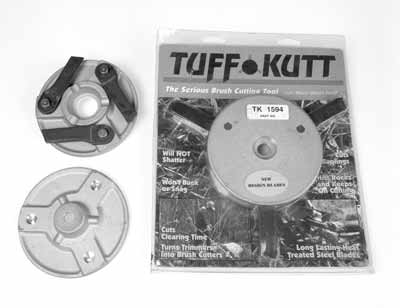 |
 |
Technology & Development Center |
| December 2003 | 2400 | 0324–2336-MTDC |
Andy Trent, Project Leader
The natural regeneration of some pine species after large wildland fires can produce extremely thick stands. These stands of lodgepole pine—and in some cases, ponderosa pine—can have more than 15,000 seedlings per acre. As the stands grow, they become extremely dense. Individual trees grow very slowly. The stands provide poor habitat for some wildlife, including large mammals such as elk, deer, and bears. In addition, the stands are susceptible to disease and insects. The stands will thin themselves naturally over time, but that process takes many years.
Thinning these stands is an important step in producing and maintaining sustainable ecosystems. Precommercial thinning (thinning before the trees are large enough to sell) can be accomplished during various stages of a stand’s life. Precommercial thinning is often conducted when trees are large enough for a chain saw to fell them easily. However, in thick, natural regeneration stands, it may be many years before the trees are that large. Meanwhile, these stands will be stagnant and the habitat will be poor for some species of wildlife. Thinning also can be done when the seedlings are very small, for example, a 1-inch stem diameter or smaller. Thinning at this stage eliminates competition between trees, allowing the remaining trees to grow faster and produce a stand that is more suitable for wildlife.
Thinning young stands has problems that must be addressed. Many trees will have lower limbs that are on or near the ground. The trees must be severed below these limbs to kill the tree. Chain saws are unsuitable, because the saw may strike rocks or the ground. Hand pruners can be used, but using them is very labor intensive and usually cost prohibitive. Brush-clearing saws (figure 1) with circular saw blades are usually the most efficient method, but the blade must be resharpened repeatedly or replaced if it strikes a rock or the ground. Table 1 describes the advantages and disadvantages of three methods for thinning small-diameter stands.

Figure 1—Stihl brush-clearing saw.
Table 1—Advantages and disadvantages of different methods to precommercially thin small-diameter stands.
| Cutting tool | Site conditions | Advantages | Disadvantages |
|---|---|---|---|
| Chain saw | Larger diameter trees (over 2 inches) | Relatively fast; more equipment and contractors are available. | Dangerous when cutting close to the ground; frequent sharpening is needed when striking the ground or rocks; must wait until a stand has thinned itself, resulting in poor habitat and tree growth; hard on the operator. |
| Brush-clearing saw | Smaller diameter trees (under 2 inches) | Relatively fast; easier on the operator; less fatiguing than using a chain saw. | Frequent resharpening if the blade strikes the ground; many more trees have to be cut than when stands have larger diameter trees. |
| Hand pruners | Smaller diameter trees (under 1 inch) | Pruners can cut into the ground below the lowest whorl; less fatiguing. | Very slow; stooping can be hard on an operator’s back; many trees have to be cut; high cost. |
The Missoula Technology and Development Center (MTDC) was asked to investigate tools to precommercially thin stands that regenerate naturally after a fire. A market search uncovered a new brush-clearing saw attachment that claimed to eliminate many of the problems associated with circular saw blades. The commercial tool is called the TUFF KUTT (figure 2). The TUFF KUTT is an attachment made of an aluminum-alloy housing with three replaceable steel blades that form a flail-type cutting mechanism.

Figure 2—TUFF KUTT brush-clearing saw head.
The Forest Service, United States Department of Agriculture (USDA), has developed this information for the guidance of its employees, its contractors, and its cooperating Federal and State agencies, and is not responsible for the interpretation or use of this information by anyone except its own employees. The use of trade, firm, or corporation names in this document is for the information and convenience of the reader, and does not constitute an endorsement by the Department of any product or service to the exclusion of others that may be suitable. The U.S. Department of Agriculture (USDA) prohibits discrimination in all its programs and activities on the basis of race, color, national origin, age, disability, and where applicable, sex, marital status, familial status, parental status, religion, sexual orientation, genetic information, political beliefs, reprisal, or because all or part of an individual’s income is derived from any public assistance program. (Not all prohibited bases apply to all programs.) Persons with disabilities who require alternative means for communication of program information (Braille, large print, audiotape, etc.) should contact USDA’s TARGET Center at (202) 720-2600 (voice and TDD). To file a complaint of discrimination, write to USDA, Director, Office of Civil Rights, 1400 Independence Avenue, S.W., Washington, D.C. 20250-9410, or call (800) 795-3272 (voice) or (202) 720-6382 (TDD). USDA is an equal opportunity provider and employer.
|
| Continue |